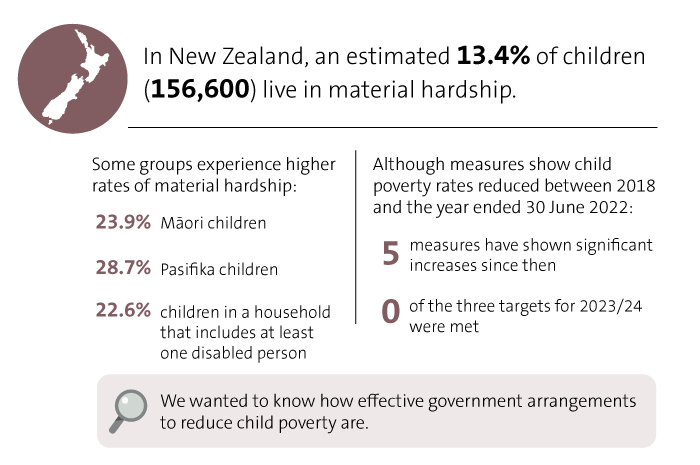Effectiveness of arrangements for reducing child poverty

Summary of our report
In New Zealand, an estimated 13.4% of children live in material hardship. Māori, Pasifika, and children living in a household where there is at least one disabled person all experience higher rates of material hardship (23.9%, 28.7%, and 22.6%, respectively).
Inequities in the rates of child poverty can lead to inequities in school achievement, adult employment, income levels, and behavioural, health, and cognitive outcomes.
Although measures show child poverty rates reduced between 2018 and the year ended 30 June 2022, five measures show significant increases since then. None of the three targets for 2023/24 were met.
The 10-year targets (to 2027/28) for the three primary measures in use are ambitious, aiming to reduce the proportion of children in poverty by more than half. To achieve this, the agencies need to work collectively. They need to plan and provide a co-ordinated and coherent response that includes the interventions agreed by Ministers and considers how these work with services provided by both public organisations and non-government organisations.
What's in this report
Why we looked at child poverty
We considered it important to carry out this audit because of the serious and long-term consequences of child poverty. We also wanted to understand the work Ministers and public organisations are doing to address the significant inequities in child poverty rates.
Arrangements to reduce child poverty
We describe the legislative requirements related to reducing child poverty, the multiple measures and indicators used, the roles of the agencies, and the changing governance arrangements.
Oversight of the child poverty work programme
We assess the oversight of the child poverty work programme, including planning, measuring, monitoring, and reporting.
Meeting the needs of our most disadvantaged
We discuss the effectiveness of governance and management arrangements to meet the needs of some of our most disadvantaged, including those living with chronic or multiple socio-economic disadvantages.
Communication with the public
We look at the effectiveness and transparency of the agencies' communication with the public. Child poverty reports are not always easy for the public to understand, largely because the multiple child poverty measures are complex.
Our recommendations
We make three recommendations for the agencies and Ministers to consider while implementing The Child and Youth Strategy 2024-2027 and the work programme to reduce material hardship.
